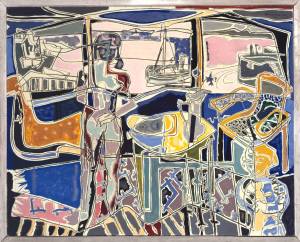

Patrick Heron lived with his family in West Cornwall as a young child. He moved away when his father extended his highly successful fabric printing business but Patrick continued to return for holidays. In 1946 he was so inspired by the Braque exhibition at the Tate that the influence of Cubism can clearly be seen in Long Table with Fruit 1948 and Harbour Window with Two Figures 1950.
He moved from London in 1956 and worked in what had been Ben Nicholson’s studio above the fishermen’s cellars at Porthmeor, St Ives. In the same year Heron, in his role as Art Critic, visited the Tate exhibition on Abstract Expressionism, the gestural brushstrokes and use of colour by American artists such as Jackson Pollack and Mark Rothco were a revelation. Their art work is dependent on the viewer’s reaction – just like a reader interprets what is read, so the paintings needed a two way communication between painting and viewer.
Patrick Heron’s first professional work was at the age of 14 when producing designs for his father. He was passionate about colour and how colour combinations work together so it is not surprising that the 1956 exhibition made such a large impact on his work. From that time he investigated colour and space. He claimed that colour in itself was the meaning, image and form in his work.
![[title not known] 1998-9 by Patrick Heron 1920-1999](https://budelookgroup.files.wordpress.com/2014/11/from-brushwork-series-98-9.jpg?w=361&h=273)
This is one of the screen prints recently exhibited at Tate St Ives.
Patrick Heron is also famous for his stained glass window in the foyer of Tate St Ives. Colour makes its impact as soon as the visitor enters the building.

